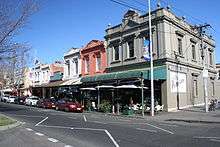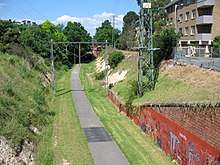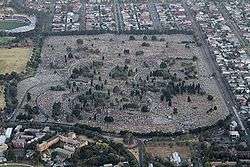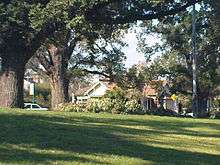Carlton North, Victoria
Carlton North is an inner suburb of Melbourne, Victoria, Australia, 4 km north from Melbourne's Central Business District. Its local government areas are the Melbourne and Yarra. At the 2016 Census, Carlton North had a population of 6,300.[1]
| Carlton North Melbourne, Victoria | |||||||||||||||
|---|---|---|---|---|---|---|---|---|---|---|---|---|---|---|---|
 Aerial view of Carlton North looking north from Carlton. On the left is Melbourne General Cemetery | |||||||||||||||
 Carlton North | |||||||||||||||
| Coordinates | 37.784°S 144.969°E | ||||||||||||||
| Population | 6,300 (2016 census)[1] | ||||||||||||||
| • Density | 3,320/km2 (8,590/sq mi) | ||||||||||||||
| Established | 1860s | ||||||||||||||
| Postcode(s) | 3054 | ||||||||||||||
| Area | 1.9 km2 (0.7 sq mi) | ||||||||||||||
| Location | 4 km (2 mi) from Melbourne CBD | ||||||||||||||
| LGA(s) | |||||||||||||||
| State electorate(s) | Melbourne | ||||||||||||||
| Federal Division(s) | Melbourne | ||||||||||||||
| |||||||||||||||
The suburb is bordered by Princes Street and Cemetery Road to the south, Royal Parade to the west, Nicholson Street to the east and Park Street to the north. Carlton North is home to the Melbourne General Cemetery and the Princes Park, which contains the Princes Park Football Ground.
Its main commercial area is along Rathdowne Street, which has numerous cafés, restaurants, small fashion boutiques, bookshops and other businesses.
Today, Carlton North, like other inner-northern suburbs of Melbourne, contains a mixture of white-collar professionals, bureaucrats and academics. The area has become more gentrified than Fitzroy North, Brunswick or Collingwood, resulting in significantly higher median property prices.
History
Carlton North has its origins with the allotment of the Melbourne General Cemetery in 1853. Previous cemetery sites at Flagstaff Gardens and (what is now) Queen Victoria Market had become full, thus the new Carlton North site was established. In the same year a prison stockade, Collingwood Stockade, was built on Lee Street. This subsequently became an asylum until 1873 when it became the area's first primary school. A bluestone quarry was established at what is now Curtain Square. Subdivision into residential blocks began in 1869, with the emerging brick terrace houses standing in contrast to Carlton's timber cottages. Princes Park was established in 1844 and became home to the Carlton Football Club in 1864.
Cable tram lines were installed along Lygon Street, Rathdowne Street, and Nicholson Street in the 1880s. The Lygon and Nicholson street routes were subsequently converted to electric traction, but the Rathdowne Street route was closed in 1936 and replaced with buses. The area was also serviced by the Inner Circle railway line (passenger services were ceased in 1948 although it remained a goods line until 1980). However Carlton North station was located in Princes Hill and no railway station was ever built in Carlton North.
Demographics
In the 2016 Census, there were 6,300 people in Carlton North. The most common ancestries were English 24.6%, Australian 17.0%, Irish 12.4%, Scottish 9.2% and Italian 7.6%. 70.0% of people were born in Australia. The next most common countries of birth were England 3.7%, New Zealand 3.1% and Italy 2.4%. 77.1% of people spoke only English at home. Other languages spoken at home included Italian 4.5% and Greek 1.6%. The most common responses for religion were No Religion 54.3% and Catholic 18.9%.[1]
Commerce and culture

The main commercial precincts in Carlton North are the strip on Rathdowne Street (called 'Rathdowne Village') and the northern end of Nicholson Street. The most notable businesses in the area include the original La Porchetta pizza restaurant (which has since become an Australia and New Zealand-wide franchise) and the Natural Tucker Bakery.
In 2010 St Michael's Anglican Church celebrated its 125th anniversary.
The Albanian Mosque in Carlton North is the oldest mosque in Melbourne, built by Albanian Australians in the late 1960s.[2][3][4]
Dancehouse, a centre for independent contemporary dance, is located on Princes St in the former Carlton Hall.
Housing
Carlton North has a large amount of Victorian and Edwardian era attached and semi-detached terrace houses. Since the 1950s as a result of gentrification many of these properties have been renovated.
In 1968 the announced acquisition by the Housing Commission of Victorian of a block of houses on an area bounded by Lygon, Princes, Lee and Drummond Street (the "Lee Street block" became the trigger for the formation of the Carlton Association in March 1969. Following the placement of a Black Ban on the site by a number of trade unions (including the Builders Labourers Federation) and a strong public relations and lobbying campaign by the resident action group the Carlton Association were successful in seeing the site saved by 1973, with a number of the properties heritage listed by the National Trust. Parts of Carlton North's housing also came under threat during the 1970s as a result of the Housing Commissions 'urban renewal' program as well as plans to construct the F19 Freeway through the suburb, however the activities of the Carlton Association, trade unions and other community activists prevented this from occurring and the suburb remains one of the very few in inner Melbourne without any Housing Commission flats. Today large parts of Carlton North are covered by various heritage overlays. ]
Pubs
- The Great Northern Hotel
- The Kent Hotel
- The Brandon Hotel
Transport

The suburb is serviced by the main roads of Royal Parade, Lygon Street, Princes Street, Rathdowne Street and Nicholson Street.
Tram routes run north-south along Royal Parade (route 19), Lygon Street (routes 1 & 6) and Nicholson Street (route 96).
The railway station which was located in Princes Hill was closed to passengers in 1948 and freight in the early 1980s. Part of the former line was utilised for Housing Commission units for the elderly and part was turned into a rather long and narrow park. Carlton North also has significant segregated bicycle facilities, including the Capital City Trail. The Carlton North section is a converted rail trail.
Parks and open space
- Curtain Square
Melbourne General Cemetery

Melbourne General Cemetery is a large (43 hectare) necropolis which is notable for containing the graves of four Australian Prime Ministers: James Scullin, Sir Robert Menzies, Harold Holt and Sir John Gorton.[5] Holt's stone is a memorial as his body was never recovered after he disappeared at sea. The tomb of famous Australian explorers Robert O'Hara Burke and William John Wills (see Burke and Wills expedition) is also located in the cemetery, with an inscription reading "Comrades in a great achievement and companions in death."
-Curtain Square
Princes Park

Educational facilities
- Princes Hill Secondary College
- Carlton North Primary School (aka Lee Street) http://www.carltonnthps.vic.edu.au/
Street names
Street names (north/south from west to east)
- Lygon: There appear to be two candidates for Lygon Street, the western most street. General Henry Lygon, a conservative MP in Britain or his younger brother Edward Pyndar Lygon, who served in the 2nd Life Guards, was Colonel of the 13th Hussars, became a General, and served for a shorter period as an MP in Britain.
- Drummond: Captain Thomas Drummond (10 October 1797 – 15 April 1840), from Edinburgh, Scotland, was an army officer, civil engineer and senior public official.
- Henry (off Newry)
- Rathdowne: Henry Monck, the 'very Orange Earl of Rathdowne', sat in the House of Lords in Britain in the period Wellington was Prime Minister.[6] See a history of Rathdowne Street
- Sutton (off Curtain)
- Amess (north from Fenwick): Samuel Amess was Melbourne’s foremost building contractor of the 1870s. He was the Mayor of Melbourne when the Melbourne Town Hall was opened. S Amess in the Australian Dictionary of Biography Online
- Canning: Charles Canning (1812-1862), British Conservative statesman and Viceroy of India[7]
- Station: Named after the North Fitzroy railway station, formerly located a few hundred metres from the street's northern end.
- Taplin (off Fenwick and MacPherson)
- Nicholson: William Nicholson, was a member of the Legislative Council, and later Premier of Victoria from 1859 to 1860. William Nicholson in the Australian Dictionary of Biography Online
Street names (east/west from south to north)
- Davis St: Peter Davis (1815–1879), Estate Agent, Melbourne City Councillor, Mayor (1856–1857). Laid out in 1873 when the Collingwood Stockade Asylum was closed. See the article on the women of Davis Street who signed the Monster Petition for Women's Suffrage in 1891. The Monster Petition and the Women of Davis Street
- Lee St: Benjamin Wright Lee (1820-1899), Melbourne City Councillor
- O'Grady St: Thomas O'Grady (1824-1890), Melbourne City Councillor, Mayor (1872-3)[8]
- Newry St
- Curtain St & Sq: John Curtain (1835-1905) Speculator, entrepreneur, Melbourne City Councillor and member of the Victorian Legislative Assembly.[9]
- Shakespeare St:
- Fenwick St: Orlando Fenwick, Grocer, Melbourne City Councillor, Mayor (1871–72).
- McPherson St: Thomas McPherson (1823–1888), iron and steel merchant, Melbourne City Councillor, Mayor (1870–71).
- Pigdon St: John Pigdon (1832-1903), Commissioner for Sydney International Exhibition, Melbourne Exhibition, Melbourne City Councillor, Mayor (1877). Pigdon was a building contractor and businessman. Among other buildings he built St Jude's church in Carlton. An Anglican, he was a churchwarden at St Jude's, Carlton, for thirty years from 1873 and a generous pew-holder; he contributed a stained glass window in memory of his wife.[10]
- Mary St
- Park St
References
- Australian Bureau of Statistics (27 June 2017). "Carlton North (State Suburb)". 2016 Census QuickStats. Retrieved 12 April 2018.

- Saeed, Abdullah; Prentice, Patricia (2020). Living in Australia: A Guide for Muslims New to Australia (PDF). National Centre for Contemporary Islamic Studies - University of Melbourne. p. 11.CS1 maint: ref=harv (link)
- Kajtazi, Sani (23 November 2019). "Danae Bosler - City of Yarra Mayor at 50th Anniversary of the Albanian Mosque". SBS. Retrieved 5 August 2020.
- Renaldi, Erwin (19 November 2019). "Masjid Pertama di Melbourne Dibangun Oleh Pendatang Asal Albania [Melbourne's First Mosque Was Built By Albanian Migrants]" (in Indonesian). ABC. Retrieved 5 August 2020.
- https://www.findagrave.com/memorial/8535779%7C Retrieved 2010-2-20
- Leaders in the Lords 1765-1902: Government Management and Party Organization in the Upper Chambers, 1765-1902 by Richard W. Davis (Paperback - 1 April 2003)
- "Street Names: Canning street (Carlton and North Carlton)". Carlton Community History Group.
- "O'Grady, Thomas (1824–1890)". ADB.
- "Curtain, John (1835–1905)". ADB.
- "Pigdon, John (1832–1903)". ADB.
External links
| Wikimedia Commons has media related to Carlton North, Victoria. |